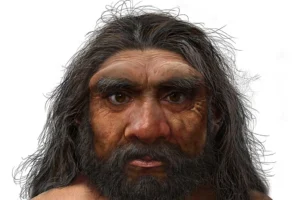Paleontologists have discovered a new species of long-necked dinosaur in Patagonia. The fossilized remains suggest that it would have been approximately 30m long and weighed 50 tons. It was as large as a blue whale and one of the largest dinosaurs ever unearthed.
Weight of the bones cracked the pavement
Scientists found the remains of Chucarosaurus diripendia in the Pueblo Blanco Nature Reserve in 2018 and finally presented their findings last week. The remains were incomplete, with only several limb bones and sections of the pelvis present.
The fossil fragments were so large that they caused the van carrying them to tip over en route to the laboratory in Buenos Aires. The bones were undamaged, but they did break the asphalt on the road! The crash inspired the new species’ name. Chucaro means “hard and indomitable animal” in Quechua, the region’s indigenous language, and diripendia means ‘scrambled’ in Latin.

A churcarosaurus next to a person. Image: The Science Times
Churcarosaurus was a long-necked herbivore that lived 90 million years ago, during the late Cretaceous Period. Studying the animal was not easy. The femur bone of this titanosaur (the grouping of the largest sauropods) measured 1.9m. Each of its three sections weighed over 100kg and required three people to lift. Despite their gigantic size, the bones were very slender.
Paleontologists are unsure why so many dinosaurs from the region grew so large. Some continued growing throughout their lives, a very unusual characteristic.

The femur bone had split into three sections. Each weighed over 100kg. Photo: Nicolas Chimento
A prehistoric hotbed
Argentina is prolific for dinosaur discoveries, with over 140 species identified. Though Churcarosaurus is the largest dinosaur discovered in the Rio Negro Province, it is not the largest discovered in Argentina. That distinction goes to Patagotitan mayorum, the largest plant-eating dinosaur. Excavated in 2014, it weighed over 70 tons and measured 37.2m.
There are more than 60 species of titanosaur from South America alone, but paleontologists have unearthed them on every continent.
“Titanosaurs are restricted to the Cretaceous and are the most common dinosaurs found in Upper Cretaceous layers of South America, particularly in Patagonia,” paleontologist Federico Agnolin told Sci News.

‘Patagotitan mayorum,’ possibly the largest land animal ever. Photo: Museo Paleontologico Egidio Feruglio
The largest dinosaur is still the subject of debate
With every discovery, researchers comment on the size and weight of the dinosaur, but it is very difficult to say which species is definitively the largest. Skeletons are rarely complete and scientists must make educated guesses based on the fragments available.
Though many consider Patagotitan mayorum the largest terrestrial animal ever, there is some debate. Argentinosaurus may have measured up to 40m long and weighed 100 tons, but paleontologists discovered very few bone fragments from the species.






